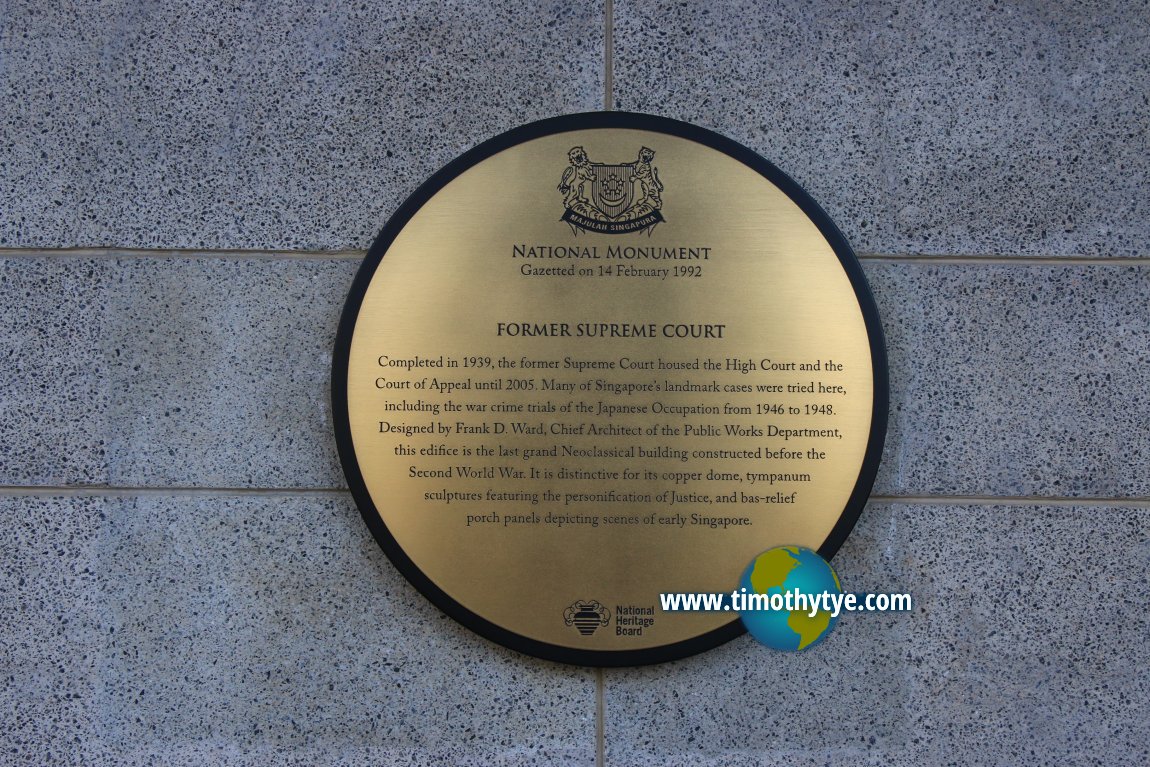 The former Supreme Court building of Singapore (2 August 2017)
The former Supreme Court building of Singapore (2 August 2017)
The Old Supreme Court Building is one of the most handsome buildings in Singapore. It is located along St Andrew's Road, just beside the equally historic City Hall building. Both have now been combined to house the National Gallery Singapore.
National Gallery Singapore
Allow me to tell you more about the National Gallery Singapore, which now occupies the former Supreme Court building.Details
The former Supreme Court was constructed between 1937 and 1939 on the site of the former Grand Hotel de L'Europe which comprised three 1830's bungalows designed by George Drumgoole Coleman. The former Supreme Court building was designed by Frank Dorrington Ward, the chief crchitect of the Public Works Department. Ward produced no fewer than eight versions of the design before deciding on this one. The Supreme Court was Ward's last and greatest work, and most critics acknowledged that it was indeed his most significant creation.
The foundation stone was laid by Sir Shenton Whitelegge Thomas, Governor of the Straits Settlements, on 1 April 1937. (Sir Shenton Thomas, after whom Shenton Way was named, was the last governor of the Straits Settlements, and was the governor before and after the Japanese Occupation.) It was, up to then, the biggest foundation stone laid in the whole of Malaya. A time capsule containing six Singapore newspaper and a handful of Straits Settlement coins were buried beneath the foundation stone, only to be retrieved in the year 3000.
The former Supreme Court was completed in 1939 and declared open on 3 August by Sir Shenton, who then handed it over to the Chief Justice of the Supreme Courts, Sir Percy McElwaine.
The most imposing characteristic of the former Supreme Court building are its Corinthian and Ionic columns, as well as the tympanum sculpture on the pediment. These were the work of Cavalieri Rudolfo Nolli, a Milanese sculptor. The centre figure in the tympanum, holding a sword in the left hand and scales in the right, is Justice. The figure immediately to its left represents the lost soul begging for protection from it. Next to this figure are two legislators with books in hand, representing the Law. To the left of Justice is a figure who bows in gratitude. Then we see a man holding a bull, representing Prosperity. Finally, two young children holding a sheaf of wheat represent Abundance from law and justice.
The big copper dome (oxidized to green) is one of the most distinctive features of the former Supreme Court building. However, there is in fact another, smaller dome, which is hardly visible from street level. This smaller dome used to house the library.
Now, before I end, let me add a little bit about why this building is called the former Supreme Court building. Because, right behind it, there's now a present Supreme Court building which was opened by Singapore President S.R. Nathan, on 7 January, 2006. The present Supreme Court building sits on the site of the former Colombo Court, and it is attracted quite a lot of attention among Singaporeans, not all of which are flattering. Many are questioning the reason for selecting a design from "yet another" foreign architect, in this case (Lord) Norman Foster. Another grievance aired was that the Singapore public had no opportunity to voice their opinion about the design until after it was already approved for construction. It is perhaps a bliss that the new Supreme Court building is hiding behind the more handsome structures such as the former Supreme Court and City Hall.
 The former Supreme Court plaque (28 July 2017)
The former Supreme Court plaque (28 July 2017)
List of the Historic Buildings in Singapore; Discover Singapore
 Copyright © 2003-2025 Timothy Tye. All Rights Reserved.
Copyright © 2003-2025 Timothy Tye. All Rights Reserved.
Copyright © 2003-2025 Timothy Tye. All Rights Reserved.

 Go Back
Go Back